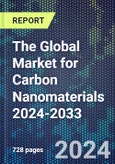The global market of carbon nanotubes is generally segmented by Multi-Walled Carbon Nanotubes (MWCNT), Single-Walled Carbon Nanotubes (SWCNT) and others (DWCNT, FWCNT). For today, MWCNT comprise the biggest share in terms of sales volumes, and production capacities. The global carbon nanotubes (CNT) market has experienced renewed growth recently, driven by demand for conductive materials for lithium-ion batteries for electric vehicles and other energy storage applications, with many producers greatly increasing production capacities. Carbon nanotube (CNT) materials have about the same level of electricity and thermal conductivity as copper and diamond and are about 100 times stronger than steel. Most of the main producers are targeting their materials as conductive additives for the batteries market. LG Chem, Cabot Corporation and CNano have expansion plans targeting the electric vehicle lithium-ion battery market.
This extensive report examines the global market for carbon nanotubes, forecasting growth in demand from 2018 to 2034. It assesses multi-walled (MWCNT) and single-walled (SWCNT) varieties, including production capacities, pricing, main producers, and applications across major end-user markets like batteries, capacitors, polymers, coatings, electronics, and sensors.
Regional demand across North America, Europe, Asia Pacific, and Rest of World is quantified. The report profiles over 160 leading producers, highlighting their products, production methods, capacities, pricing, and target markets. Alternative carbon nanomaterials like nanofibers, nanohorns and graphene are also analyzed. Latest developments in CNT-enhanced Li-ion batteries, fuel cells, lightweight composites, conductive films, transgenic drug delivery, water treatment membranes and flexible electronics are assessed.
The report examines the role of CNTs in reinforced polymers, metal matrix composites, conductive inks, coatings, tires, textiles, thermal paste and other emerging applications. Manufacturing challenges around quality, dispersion and alignment control are considered. Toxicity concerns, rival materials, outdated production claims and oversaturation risks are also evaluated.
Report contents include:
- Global demand forecasts for multi-walled and single-walled CNTs to 2034
- Analysis of CNT production methods, capacities, pricing, main producers
- CNT adoption trends in markets including batteries, supercapacitors, polymers, composites
- Application requirements, rival materials, toxicity concerns
- Cost structure analysis, scalability assessments, commercial risks
- CNT market growth drivers
- Developments in conductive films, fuel cells, sensors, drug delivery
- Flexible electronics, wearables, aerospace uses of CNTs
- Water treatment, oil & gas, construction applications
- Company profiles of over 160 established and emerging CNT manufacturers and product developers. Companies profiled include Cabot Corporation, Canatu Oy, Carbice Corporation, Carbon X, C12 Quantum Electronics, Eden Innovations Ltd, Huntsman Corporation, JEIO, Korbon, LG Chem, Li-S Energy, Mattershift, MECHnano, Nanomatics Pte. Ltd, NAWA Technologies, Nano-C, Nemo Nanomaterials, NEO Battery Materials, NovationSi, OCSiAl, Raymor, Shenzhen Cone Technology, SixLine Semiconductor, SkyNano Technologies, SmartNanotubes Technologies, Somalytics, Verdox, Zeon Corporation and Zeta Energy.
- Regional demand analysis - North America, Europe, Asia Pacific, RoW
- Intellectual property landscape – recent CNT patents
This product will be delivered within 1-3 business days.
Table of Contents
Companies Mentioned (Partial List)
A selection of companies mentioned in this report includes, but is not limited to:
- Cabot Corporation
- Canatu Oy
- Carbice Corporation
- Carbon X
- C12 Quantum Electronics
- Eden Innovations Ltd
- Huntsman Corporation
- JEIO
- Korbon
- LG Chem
- Li-S Energy
- Mattershift
- MECHnano
- Nanomatics Pte. Ltd
- NAWA Technologies
- Nano-C
- Nemo Nanomaterials
- NEO Battery Materials
- NovationSi
- OCSiAl
- Raymor
- Shenzhen Cone Technology
- SixLine Semiconductor
- SkyNano Technologies
- SmartNanotubes Technologies
- Somalytics
- Verdox
- Zeon Corporation
- Zeta Energy
Methodology

LOADING...








